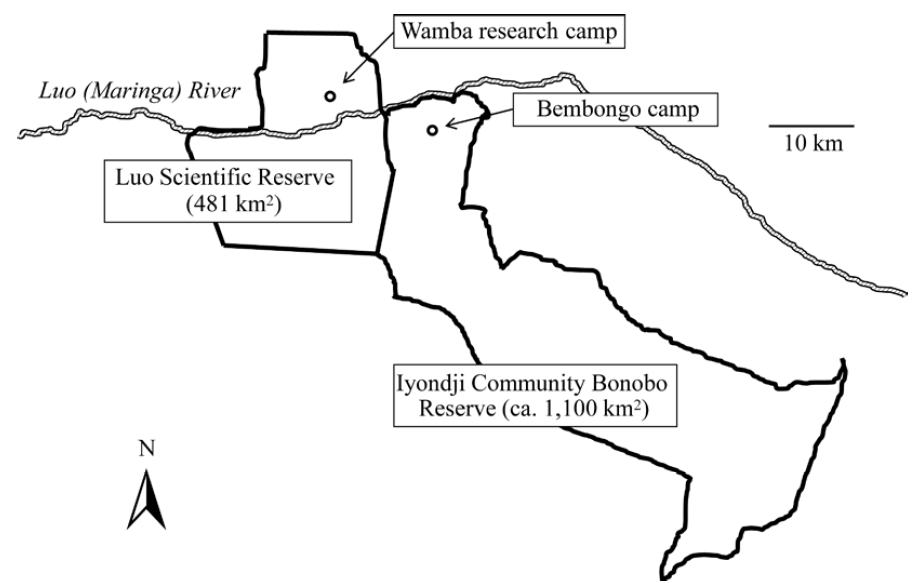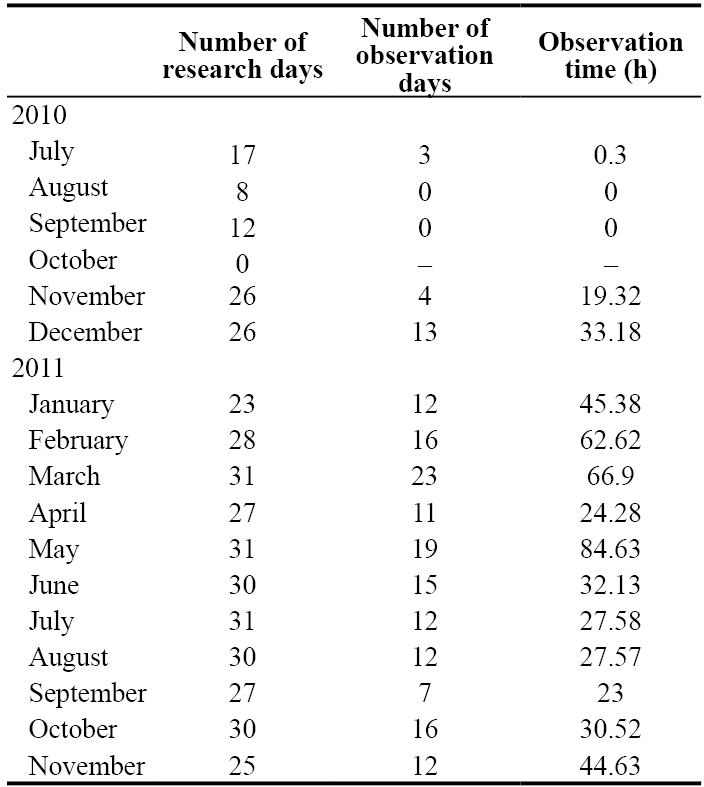|
<NEWS>
Iyondji Community Bonobo Reserve: A Recently Established Reserve in the Democratic Republic of Congo
Tetsuya Sakamaki1,2, Phila Kasalevo3, Mathieu Bolaa Bokamba4 & Lingomo Bongoli5,6
1 Primate Research Institute of Kyoto University, Japan 2 Wamba Committee for Bonobo Research 3 African Wildlife Foundation 4 Ecosystem Restorate Associate (ERA-Congo) 5 Forêt des Bonobos 6 Centre de Recherche en Ecologie et Foresterie, D. R. Congo INTRODUCTION The Iyondji Community Bonobo Reserve (ICBR), established by the Democratic Republic of the Congo (DRC) Ministry of Environment in April 2012, encompasses approximately 1,100 km˛ of tropical moist forest that harbors bonobos (bilia; Pan paniscus). The ICBR is adjacent to the southeast border of the Luo Scientific Reserve (481 km˛). Wamba, a long-term study site of wild bonobos, is situated in the northern section of the Luo Scientific Reserve1 (Figure 1). The Kokolopori Bonobo Reserve is east of the ICBR. Creation of the ICBR will benefit the conservation of bonobo habitat because it expands the protected area. The present report describes the history of the area before the ICBR was gazetted, efforts to habituate the bonobos, and current management issues and implications for the future. 
Figure 1. Map of the Iyondji Community Bonobo Reserve and the Luo Scientific Reserve. BACKGROUND Most Iyondji villagers live in settlements that extend along established roads in the northern section of the Luo (Maringa) River. Crop fields and secondary forests stretch for 1 to 2 km on both sides of the villages. Primary forest extends along the southern section of the river where temporary hunting, fishing and gathering camps and small hamlets with cassava fields lie2 (Figure 1). The local Iyondji communities (Yohala and Yokali villages) wanted to establish a community reserve in the southern section of the Luo River, and in 2007, they requested help from the African Wildlife Foundation, an international non-government organization (NGO), and the Japanese research team that had established the Wamba Committee for Bonobo Research, a long-term research project in and around Wamba. At the time, we conducted preliminary surveys and continued to train and support the community in searching for local bonobo group, and a local NGO, Forêt des Bonobos, took the initiative and carried out the project with the villagers. Between 2010 and 2011, with support from the United States Fish and Wildlife Service, efforts to gazette a new community reserve were made in earnest. HABITUATION OF BONOBOS In July 2010, habituation of the bonobos was begun on a daily basis in preparation for potential tourism or scientific research. The habituation procedure involved identifying unit-groups (or communities) and their ranges by finding footprints and food remnants, making and maintaining observation trails in the ranges, following one or two target groups on a daily basis and identifying individuals in the bonobo groups. We established a research camp at a hamlet along the Bembongo River in the northern part of the proposed protected area (0° 8′ 20″ N, 22° 44′ 37″ E; Figure 1). The Bembongo camp was 2–3 h from an Iyondji village (outside of the proposed protected area) travelling in a small boat and on foot. We found two different groups of bonobos around the camp in the first 2 months. We focused our efforts on the Bembongo Group and followed them on a daily basis. Table 1 shows the number of days the group was observed and the direct observation times during the project. The camp was situated in the northern sector of the Bembongo Group’s range. It was possible to follow the bonobos nearly every day when they were near the camp, but this was difficult when they ranged further south because their southern range was 2 h or more from the camp and we had not made observation trails further south. Table 1. Number of research days, direct observations and observation time of the Bembongo group. 
We identified the Ite Group, a unit-group that ranged in the west adjacent area and the Bohondohondo Group, which ranged in the east adjacent area. Moreover, we found evidence of other bonobo groups in the southern area of the reserve. The ICBR bonobo population borders the Wamba bonobo population. Behavioural and ecological studies of the Wamba group have been reported previously1. Given the proximity of the two groups, their habitats are unlikely to differ significantly; however, further surveys are necessary to assess the two environments. Individuals in the ICBR and Wamba groups cannot transfer between groups because they cannot cross the Luo River, which separates the two populations. Thus, the behavioural diversity or ‘culture of the ICBR bonobos is an interesting topic for future study3. CURRENT PROBLEMS AND THE FUTURE The local Bongando people (a Bantu ethnic group) are closely tied to their natural environment2. Although their most important crop is cassava, the Bongando acquire most of their animal protein from the forest where they hunt and gather various species of mammals, birds, reptiles, fish, insects and plants. They keep livestock such as goats, pigs, chicken and ducks, which are consumed in rituals and on ceremonial occasions. Effective and sustainable management of the ICBR requires the development of alternative sustainable livelihoods while controlling the use of resources in the forest. People living in the forest present additional difficulties. One objective of the 2010–2011 Iyondji project was to establish a biannual monitoring of large mammals and human activity in the proposed protected area. We originally planned to make 10 line transects (each 5 km) in the area for biannual monitoring and regular patrol. However, our monitoring walks were able to cover only four transects in the northern area because the people who lived in scattered hamlets in the middle and southern areas of the proposed protected area were not in favour of a new reserve and obstructed our work. These were not Iyondji people, but members of other populations in the adjacent administrative districts. Although the southern boundary of the ICBR was within the Iyondji jurisdiction, the Iyondji people only inhabited the forest in the northern sector of the ICBR. Temporary hunting and gathering camps and small hamlets with cassava fields were present within the ICBR. Approximately 10 people lived in a hamlet (Lingomo et al., unpublished data). According to the villagers, people lived in the forest permanently, and some of their children had never been to the villages along the established roads where there were schools and dispensaries. This situation was, in part, the result of the DRC civil war in the 1990s2. Prior to the civil war, villagers hunted primarily for their own consumption. However, during the war the trucking and shipping transportation network collapsed, and the villagers were left with no means of selling cash crops such as coffee beans. As a result, the sale of bush meat became the primary way of earning cash. Unlike the people from adjacent districts, the local Iyondji communities agreed to manage the ICBR, and they regularly monitor and patrol their forest. It is important to note that the Iyondji people were provided with opportunities for alternative livelihoods that allowed them to decrease the hunting of wild animals and habitat destruction through slash-and-burn agriculture. Continual support for the Iyondji and other adjacent communities may be necessary to resolve conflicts with the ICBR. Furthermore, it is necessary to develop innovative ways to create revenue through the forest and its bonobos, such as tourism and scientific research. At present, it is not realistic for the local communities to forego the use of resources in the forest. However, local community activities must adhere to regulations of the reserve, and regular monitoring of animals and human activity is important and necessary. Ideally, the local communities will take the initiative in carrying out regular monitoring and patrolling of their forests. Our ICBR project is a model case of collaboration among local communities, conservation NGOs and scientific researchers. At this stage of the ICBR project, the collaboration is expected to continue to help solve current problems and facilitate development of the management plan. ACKNOWLEDGEMENTS Invaluable support and logistical assistance were provided by Jef Dupain, Charly Facheux, Lillian Nsimba and other members of the Africa Wildlife Foundation (AWF); the Centre de Recherche en Ecologie et Foresterie (CREF) of the Democratic Republic of Congo; T. Furuichi, D. Kimura and other members of the Wamba Committee for Bonobo Research; members of the local NGO, Forêt des Bonobos, and the local Iyondji communities. Research permission was arranged by the CREF and the Ministry of Scientific Research of the Democratic Republic of Congo. I thank K. Hosaka and T. Furuichi for useful comments on the original manuscript. The present project was financially supported by the US Fish and Wildlife Service Assistance Award (96200-0-G017 to AWF), Grants-in-Aid for Scientific Research of the Japan Society for the Promotion of Science (JSPS) (2225507 to T. Furuichi), the Environment Research and Technology Development Fund of the Ministry of the Environment, Japan (D-1007 to T. Furuichi), and the JSPS Primate Origins of Human Evolution (HOPE) project (AS-22-027, ITP-23-006 to T. Sakamaki). REFERENCES
Back to Contents |